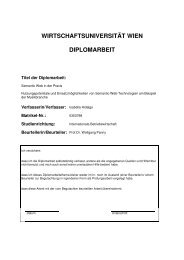Wirtschaftsuniversität Wien Magisterarbeit - SemanticLab
Wirtschaftsuniversität Wien Magisterarbeit - SemanticLab
Wirtschaftsuniversität Wien Magisterarbeit - SemanticLab
You also want an ePaper? Increase the reach of your titles
YUMPU automatically turns print PDFs into web optimized ePapers that Google loves.
webservers for administrative purposes as well as data to process customer orders, it<br />
might have two statements. These data specific assertions are:<br />
• A consequence should provide the users with information specifying why their data<br />
is actually collected and why it may be valuable for a certain service, transaction<br />
or feature. It is stated in a human-readable form using the CONSEQUENCE<br />
element. This element is optional, its usage however is strongly recommended.<br />
• If a websites does not collect identifiable data (so called non-identifiable data) or<br />
if it anonymizes this data, it may set an indicator accordingly using the NON-<br />
IDENTIFIABLE element. However, websites should note that the P3P specification<br />
provides a strict definition of anonymized: ’In order to consider the data<br />
”anonymized”, there must be no reasonable way for the entity or a third party to<br />
attach the collected data to the identity of a natural person’ [W3Ca]. This element<br />
is optional.<br />
• How the data a website collects is going to be used has to be provided using the<br />
PURPOSE element. The P3P vocabulary defines twelve purposes whereas the<br />
twelfth provides a possibility to provide human-readable information. The other<br />
eleven purposes have a predefined meaning. Table 3.1 recites the “Plain Language<br />
Translations of P3P Vocabulary Elements” of the P3P specification for these twelve<br />
elements according to [W3Ca].<br />
• The RECIPIENT element states with which parties collected data will be shared.<br />
P3P specifies six types of recipients which are listed in Table 3.2.<br />
• The data-retention policy in effect must be defined using the RETENTION element.<br />
Although no specific time is indicated, the five sub-elements can give users<br />
an indication about the websites’ retention policy which can be supported by a<br />
human-readable retention policy. Table 3.3 lists all sub-elements including their<br />
meaning.<br />
As with policy reference files, P3P policies can be assigned a language by using the<br />
xml:lang attribute. This attribute is used to identify the language of human-readable<br />
fields.<br />
Another feature already highlighted is the policy lifetime. By setting the EXPIRE<br />
element, website can provide information on how long a certain policy is valid, that is<br />
when user-agents have to re-fetch a policy for a website or certain content elements.<br />
Besides “normal” P3P policies, one can also define compact policies (CP) which<br />
represent a summary of a websites’ P3P policy for a cookie. Compact policies are transmitted<br />
via an additional HTTP response header CP. As the name suggests, compact<br />
policies do not provide the same details as P3P policies. However, compact policies are<br />
heavily used especially by Microsoft’s Internet Explorer which decides if a cookie is going<br />
to be blocked or not solely based on compact policies [Cra02].<br />
27





